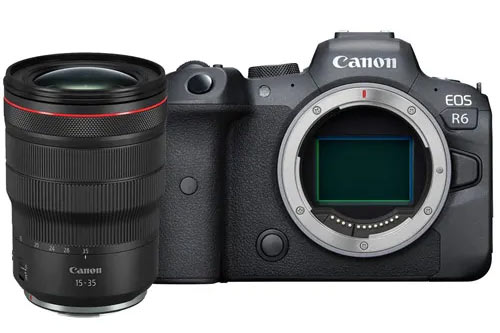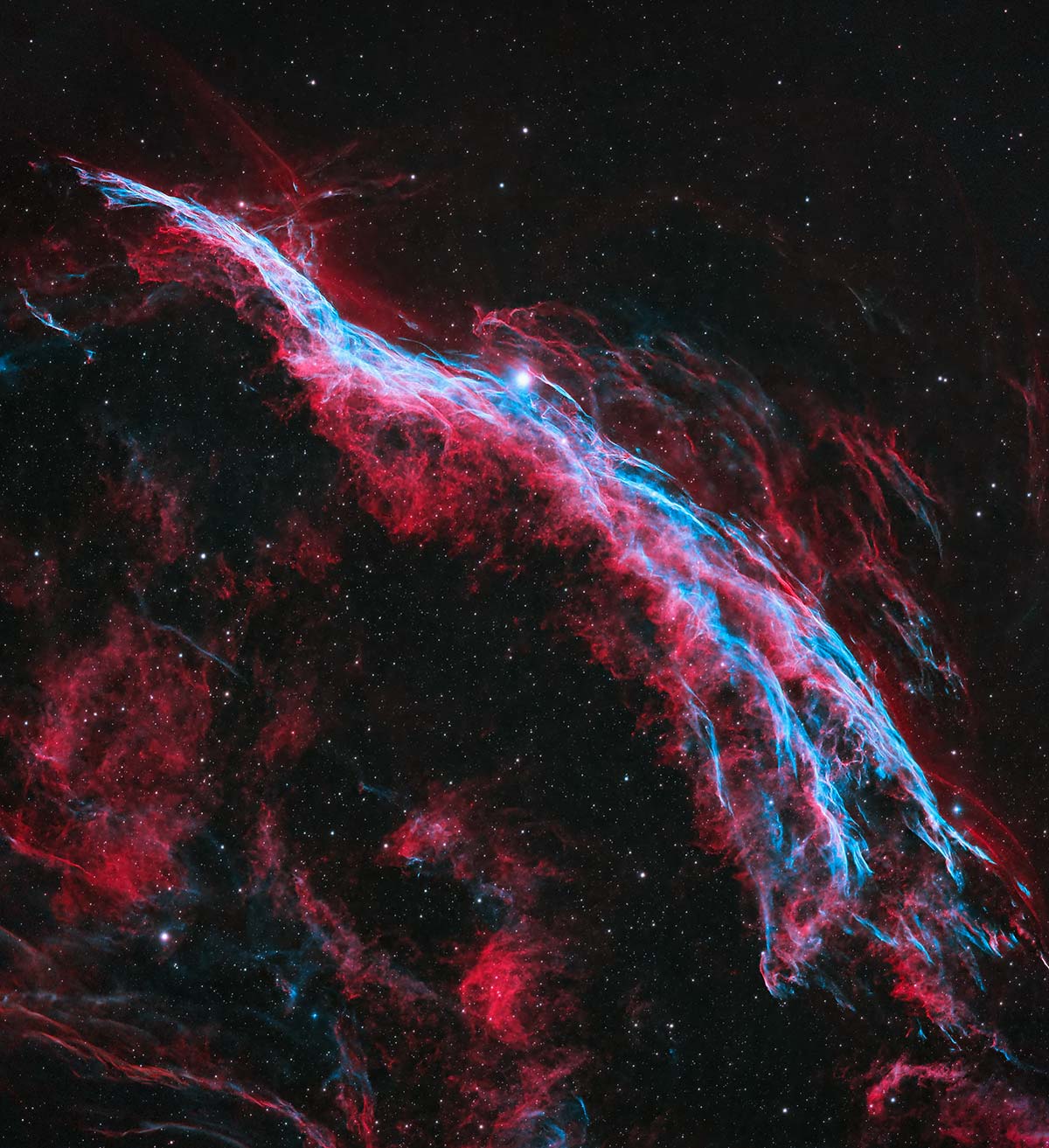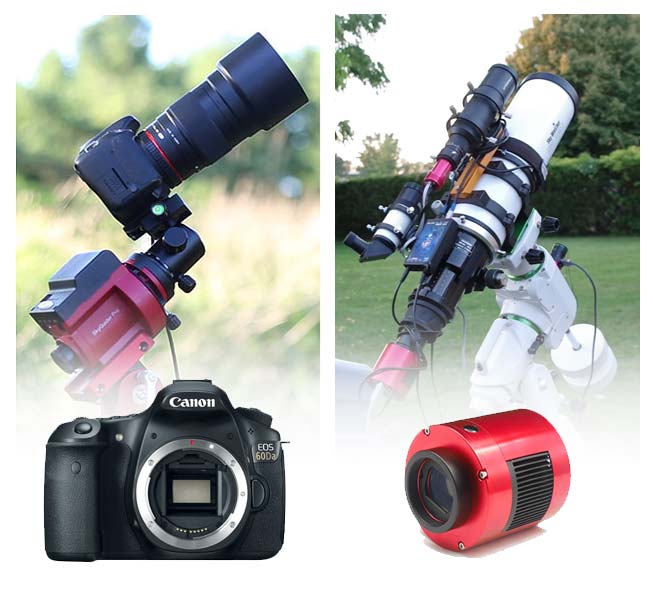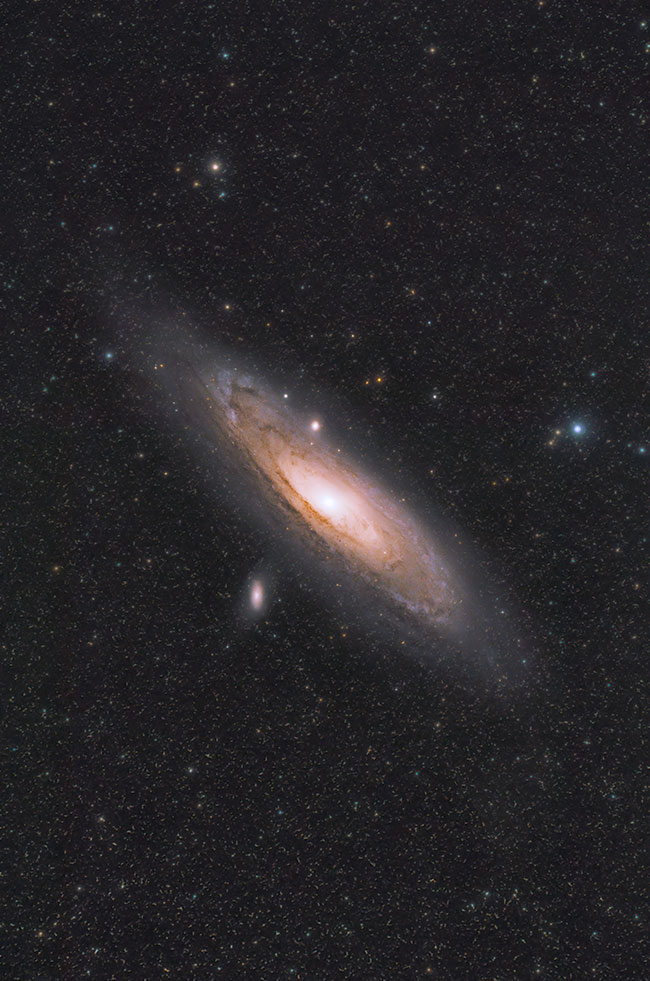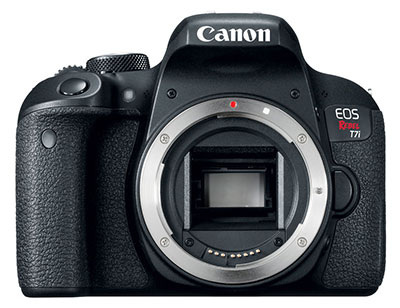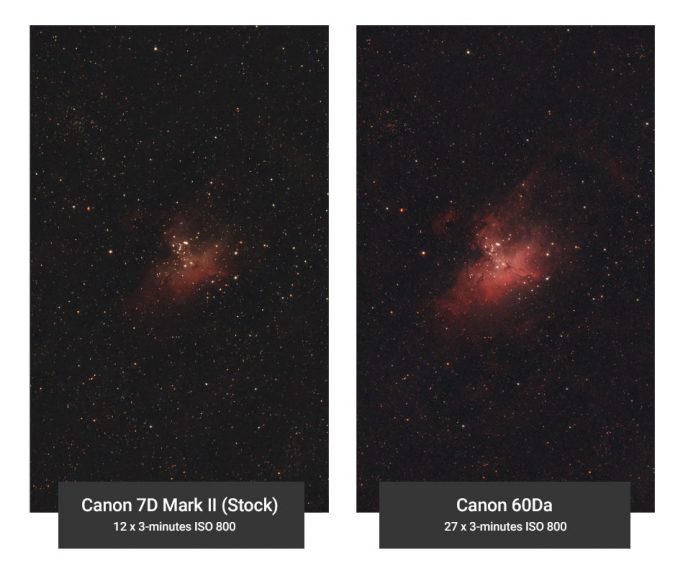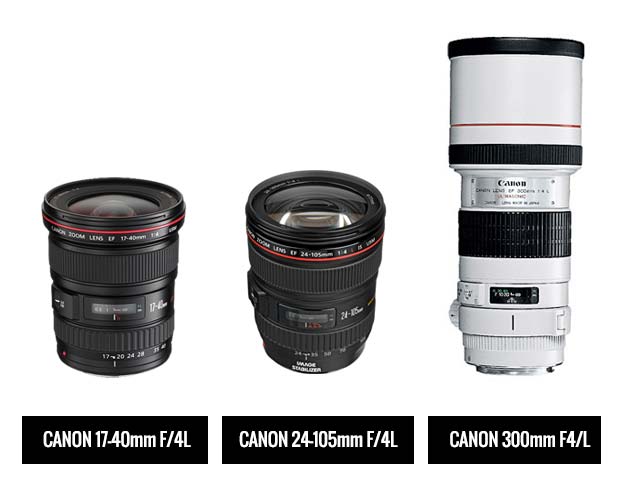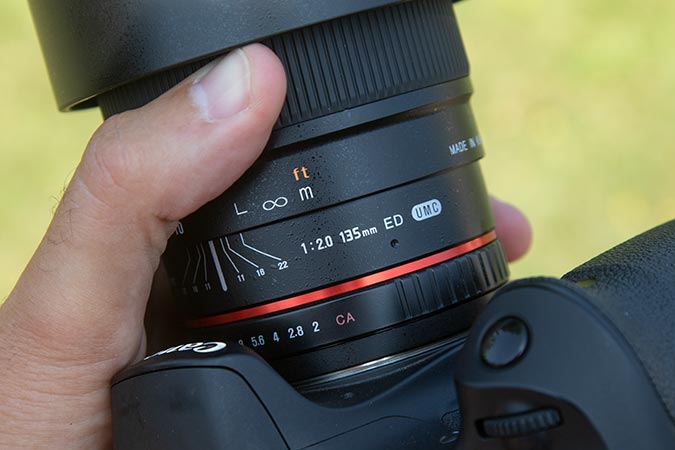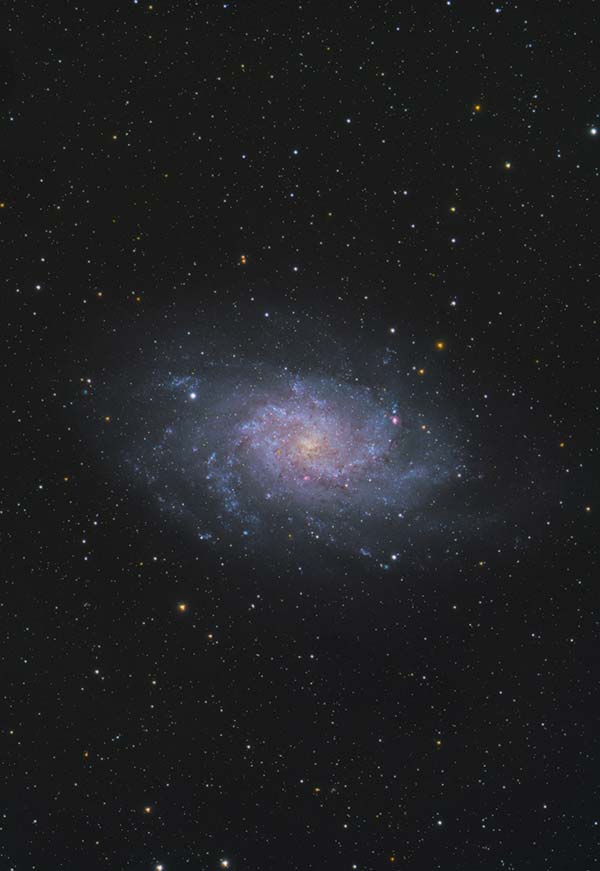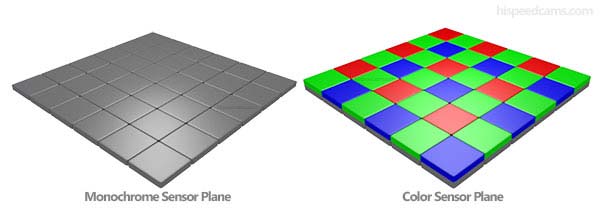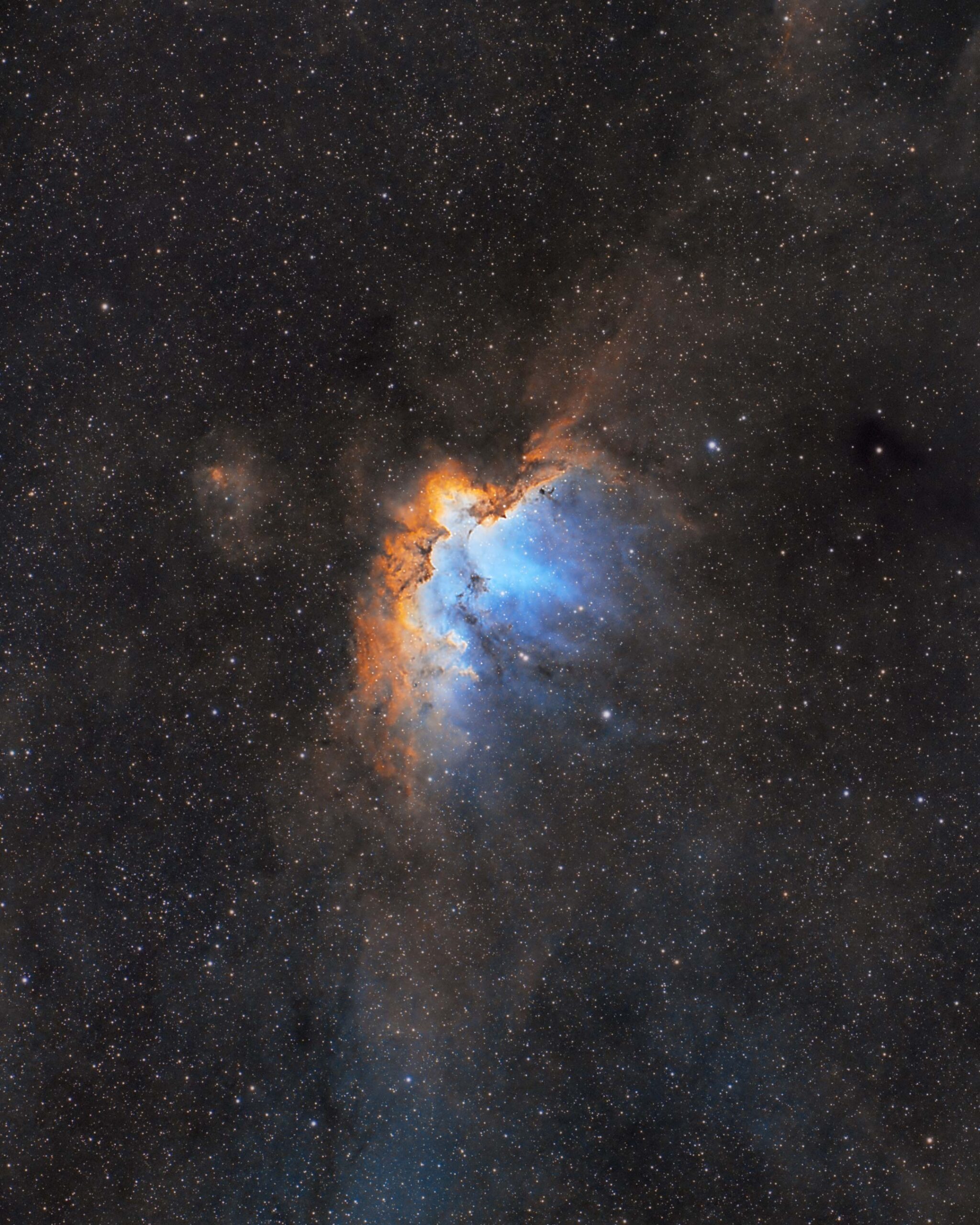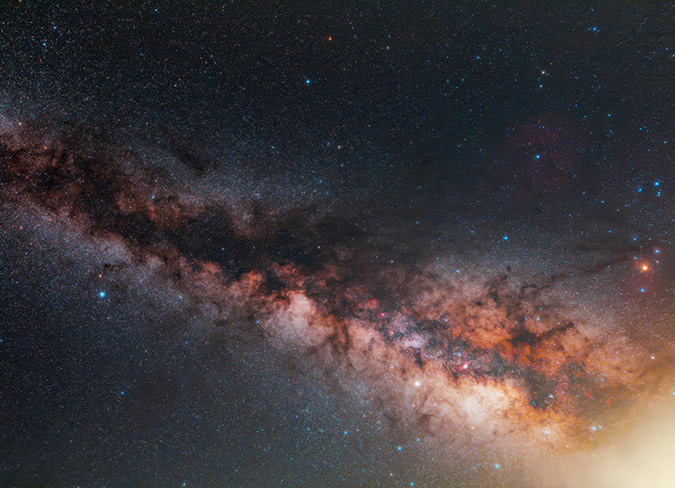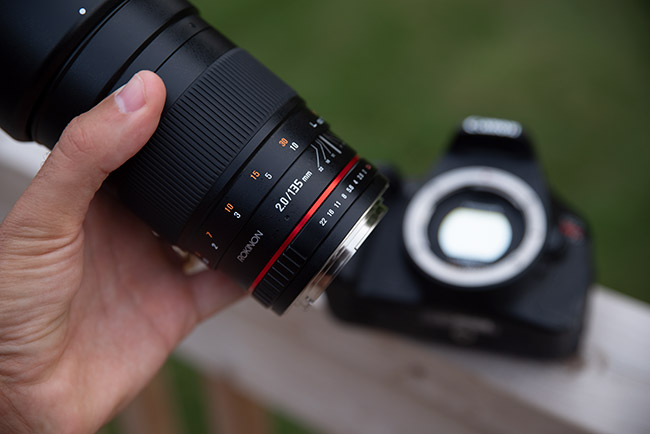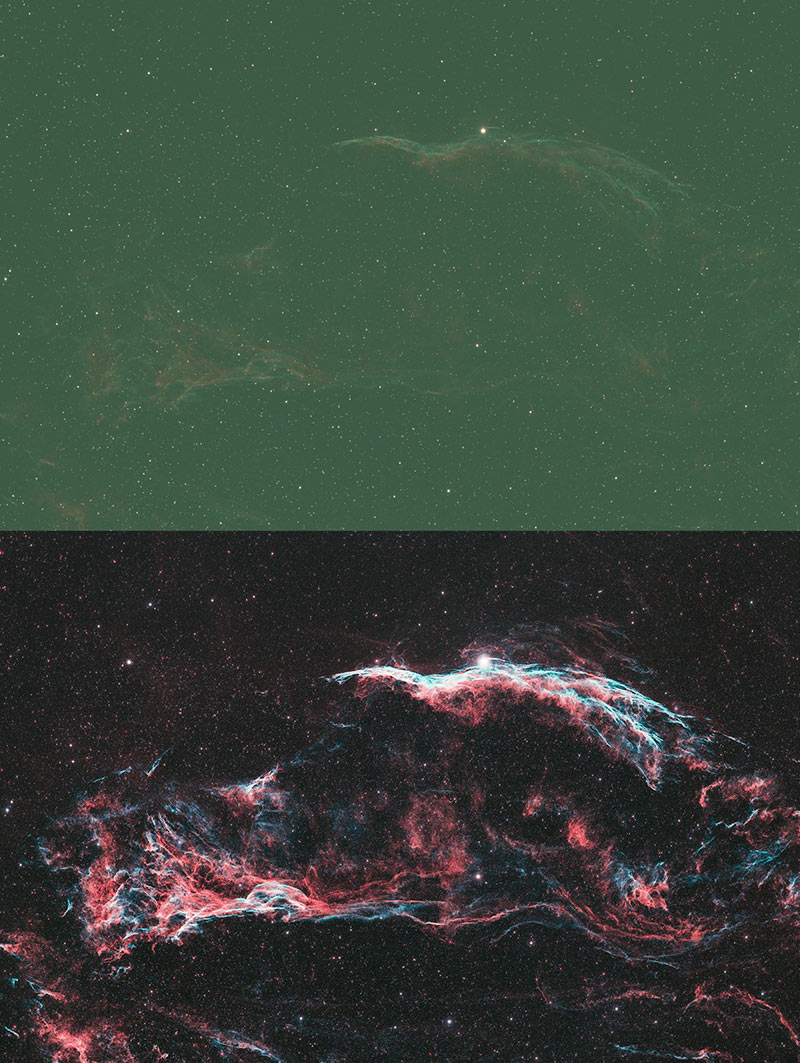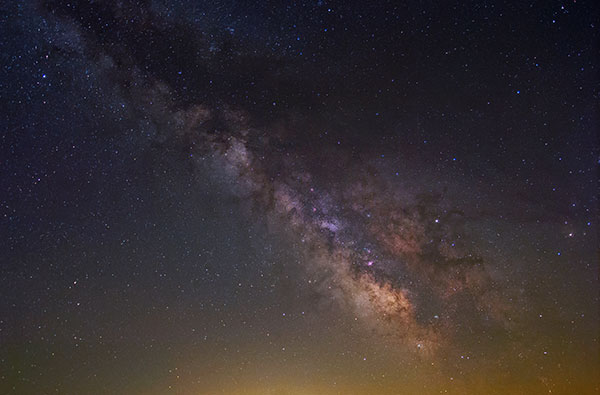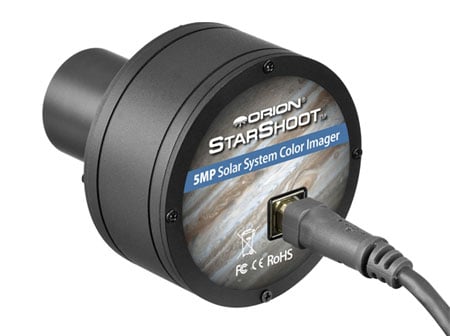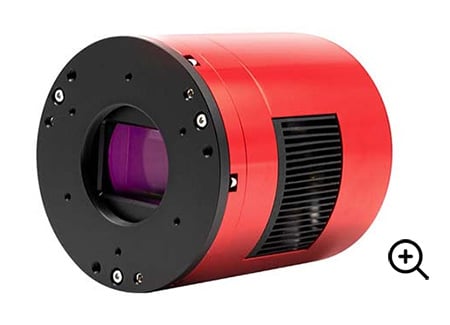Choosing an Astrophotography Camera
With so many types of astrophotography cameras available, choosing a specific model to spend your hard-earned money on can be a tough decision.
Beginners usually start with an entry-level DSLR or mirrorless camera as they are cost-effective and versatile, and I still think that’s the best way to go.
Unlike a point-and-shoot or mobile phone camera, a DSLR or mirrorless model uses an interchangeable lens, and this is extremely beneficial for astrophotography.
I use a Canon EOS R6 for astrophotography with various lenses.
If you are brand new to astrophotography, you can’t go wrong investing in an entry-level DSLR camera and kit lens. A DSLR is easy to use, affordable, and still a very relevant choice for long-exposure deep-sky astrophotography.
This will open the door to many types of astrophotography including Nightscapes, Milky Way Photography, and even Deep-Sky Astrophotography through a telescope.
The Andromeda Galaxy. Canon EOS Rebel XSi (modified).
Unlike the other astrophotography camera articles you will find online, this post shares actual photo examples of space I have taken with the cameras mentioned.
Here are some quick camera options I have shared on my YouTube channel to consider, depending on your skill level and area of interest. These are suggestions based on my personal experience. These are all cameras I have used personally and recommend for astrophotography.
- Best ‘Cheap’ Astrophotography Camera: Canon EOS Rebel T7
- Best DSLR Camera for Astrophotography: Canon EOS 6D Mark II
- Best Dedicated Astronomy Camera: ZWO ASI2600MM Pro
- Best Budget Dedicated Astronomy Camera: ZWO ASI533MC Pro
The Western Veil Nebula. ZWO ASI2600MM Pro dedicated astronomy camera.
For an in-depth look at the types and brands of astrophotography cameras available in 2024, read on. To see my latest images of space, be sure to follow me on Twitter.
Astrophotography Cameras
As the hobby evolves, more and more dedicated astrophotography cameras continue to populate the market. Despite the amazing advances in cooled CMOS sensor technology found in modern astronomy cameras, I will always continue to shoot with a DSLR camera body in some form or another because they are just too much fun.
My first astrophotography camera was a Canon Rebel 450D, and I haven’t spent a season without using a DSLR camera since. Since then, I have purchased nearly a half dozen cameras for astrophotography, with the latest edition being the full-frame Canon EOS Ra.
Canon, Nikon, and Sony are the leaders of the DSLR and mirrorless camera market when it comes to astrophotography.
In the dedicated astronomy camera world, ZWO ASI, and QHYCCD seem to dominate the amateur astrophotographer market.
The brand you choose can have a huge impact on your future equipment options. This goes for both DSLR/mirrorless cameras and dedicated astronomy cameras.
For instance, Canon users are much more likely to stay loyal to the brand after purchasing multiple camera lenses made for a Canon DSLR body. Whichever brand of DSLR you choose in the beginning, you are more likely to stick with it until the end, so choose wisely.
If you’re first dedicated astronomy camera is a ZWO ASI camera, you may choose to invest in a ZWO ASIAIR wifi device. If this is the road you take, remember that this device will only run ZWO ASI cameras.
The Best “Cheap” Astrophotography Camera
If you’re looking for the best cheap astrophotography camera, a Canon Rebel DSLR is tough to beat. They are highly capable astrophotography cameras (for both deep-sky and nightscapes) and can be found used for as little as $250.
In 2022, I proved that a DSLR camera is still a valid choice for astrophotography by photographing a galaxy from my backyard using an aging Canon EOS Rebel XSi.
While a dedicated astronomy camera is generally better suited for long-exposure deep-sky astrophotography than a DSLR, they require additional hardware and software to run. They can also be more complex to use than an entry-level DSLR camera because there is no onboard control screen.
My advice would be to start with an entry-level body such as the Canon Rebel T7i or Nikon D3400. Both of these cameras support a staggering amount of camera lenses and software applications. The Sony mirrorless a7 series cameras look impressive for wide-angle landscape-style astrophotography, but I see very few people using them for deep sky imaging.
A DSLR camera is very versatile and easy to use with various lenses. A dedicated astronomy camera, on the other hand, is designed primarily for deep-sky imaging through a telescope and requires dedicated software to run. I currently use both types of astrophotography cameras on a regular basis.
If you already own a DSLR for daytime photography, I would definitely recommend trying it out for astrophotography before looking to upgrade. The professional-level DSLRs from Canon and Nikon such as the 5D Mark IV and Nikon D850 would make excellent astro-cameras.
For an idea of what a DSLR camera is capable of, have a look at the following image of the Andromeda Galaxy captured using a Canon 60Da. This camera body is rather unique in the fact that it was actually designed specifically for astrophotography.
The Andromeda Galaxy using a Canon EOS 60Da.
If it’s your first “real camera”, it’s worth thinking about purchasing your model of choice in a bundle that includes a zoom kit lens. One of the best ways to get started in astrophotography is to use the DSLR with a camera lens, not a telescope.
This method can be enjoyed both on a tripod, or on a simple tracking mount (star tracker) such as the iOptron SkyTracker Pro, or Sky-Watcher Star Adventurer. A DSLR camera and lens are simple and easy to mount for long exposure, tracked images of the night sky.
When you have invested in your first astrophotography telescope, you can then attach your DSLR camera via a T-ring and adapter. This is known as prime-focus astrophotography and can lead to an extraordinary world of deep-sky imaging. This is where my true passion for this hobby began to take shape.
I recommend the Canon EOS Rebel T7 for beginners.
Modifying a DSLR for astrophotography
When you hear the term “modified DSLR” in the astrophotography realm, it means that the stock IR cut filter has been removed to allow the red color from certain nebulae to be recorded.
To be more specific, it’s the hydrogen-alpha transmission line (656nm) that’s so important for astro-imaging. Cameras like the Canon EOS 60Da were designed to be more sensitive to this wavelength, but an ordinary DSLR camera is not.
Having a camera that is sensitive to this wavelength of light (Hα) can make a big difference when it comes to certain emission nebulae such as the California Nebula, Eagle Nebula, and many more.
For those looking to take advantage of this modification, you can send your camera away for a professional modification service or perform the modification yourself.
With my first astrophotography camera (Canon EOS Rebel Xsi), I carefully removed the stock IR cut filter in the camera with the aid of this tutorial video. I am happy to report that after 4 intense hours of work, I was successful.
Examples of images taken using a stock vs. a “modified” DSLR camera.
In 2020, I tested a new astrophotography camera developed by Canon. The Canon EOS Ra is a full-frame mirrorless camera capable of capturing stunning high-resolution images. This is a new breed of camera, not only because of its mirrorless design, but also features like 4K video and 30X live-view focus.
Like the Canon EOS 60Da that launched before it, it is more sensitive to the h-alpha wavelength of the light spectrum than a traditional daytime photography camera.
The Canon EOS Ra full-frame mirrorless camera (30.2 MP CMOS Sensor).
Camera Lenses for Astrophotography
I have used a number of lenses for astrophotography purposes over the years, and a few models stand out above the others.
Below, you’ll see 3 Canon L-Series lenses of varying focal lengths that I like to use on assorted projects. If you aren’t ready to invest in a high-end lens like this, you could always consider a camera-lens rental service.
Astrophotography with a camera lens is a lot of fun, and can often be a simpler and more enjoyable experience than with a telescope. Even a kit lens such as the 18-55mm that is included with many beginner-level DSLRs has some excellent astrophotography potential.
Wide-angle lenses such as the Rokinon 14mm F/2.8 make it possible to capture entire regions of the Milky Way at once. As the focal length of the lens increases, so will the demand of tracking accuracy and precise polar alignment.
Check your local classified market for deals on used lenses. Most of my camera lenses were purchased used from either a classified site or from “used” camera lens section of an online photography store.
Smaller camera lenses are much lighter than most telescopes, which means you won’t require a large equatorial mount to track the sky. Heavier telephoto lenses such as the Canon 300mm F/4L will require a more robust mount such as the iOptron SkyGuider Pro.
The Rokinon 135mm F/2 lens is an excellent choice for large deep-sky targets.
Dedicated Astronomy Cameras
These days there are many dedicated astronomy cameras on the market that are designed specifically for astrophotography, and nothing else. They lack a display screen and camera controls on the body and must be controlled using dedicated software on your computer.
Cameras with CMOS sensors that include TEC (Thermoelectric cooling) and precision gain controls can produce images in .FIT format, and are extremely popular for astrophotography. Dedicated astronomy cameras come in two formats, one-shot-color, and mono. If you are like me, and your clear sky time is limited, a one-shot-color camera is a very convenient choice.
For example, the ZWO ASI294MC Pro houses a 4/3″ Sony IMX294 CMOS Sensor capable of capturing beautiful high-resolution images (4144 x 2822 pixels) in full color.
The Cocoon Nebula captured using a ZWO ASI294MC Pro color camera.
Years ago, CCD cameras ruled the market in this category, but advancements in CMOS sensor technology have increased the popularity of brands like ZWO Astronomy Cameras. A camera with a monochrome sensor such as the ZWO ASI1600MM Pro records images in greyscale, meaning that a minimum of 3 filters (R, G, B) are necessary to create a full-color image.
Mono CMOS sensors are much more sensitive than their color counterparts, you just have to work a little harder. As you take pictures through each color or narrowband filter, you benefit from a stronger signal due to the lack of the Bayer filter (CFA) found in traditional color cameras.
ZWO cameras have the option of being controlled using a unique dedicated camera capture device called the ZWO ASIair. This Raspberry Pi-based computer allows you to control ASI cameras from your smartphone or tablet. Here, you can control everything from autoguiding to plate solving without touching your telescope.
I have found that using this particular camera with a duo-narrowband filter can produce some incredible results in a light-polluted area. The following image uses the STC Astro Duo-Narrowband filter with the ASI294MC-Pro on the Pacman Nebula.
The Pacman Nebula using the ZWO ASI294MC-Pro camera.
The image was captured from a Bortle Scale Class 8 region (my backyard) during a nearly full moon. The combination of a cooled sensor and a narrow bandpass filter allows amateur astrophotographers to take impressive images from the city.
The camera was set to -20°C to keep thermal noise at bay and resulting in 5-minute image subs with an impressive signal-to-noise ratio. If you told me this photo was captured from my city backyard 2 years ago, I wouldn’t have believed you!
When using this camera under a dark sky (Bortle Class 3), my results using the ASI294MC-Pro unfiltered (Just a UV-IR filter) were impressive. The following image of the Triangulum Galaxy was captured at the Black Forest Star Party through a Sky-Watcher Esprit 100 telescope.
The Triangulum Galaxy using a Dedicated Astronomy Camera.
Astrophotography Cameras under $1,000
Only a few short years ago, purchasing a dedicated CCD camera for astrophotography for under $1000 was unheard of. Modern advancements in CMOS sensor technology have brought the price of these cameras down significantly.
Dedicated astronomy cameras that are capable of cooling the sensor for a cleaner signal are now much more obtainable to the casual or beginner-level astrophotography enthusiast. The cameras listed below are best for deep-sky astrophotography. A different type of camera (and approach) is required for planetary or solar imaging.
I have included some very capable DSLR cameras on my list as well, as I believe they are still very relevant choices for most astrophotographers. The crop-sensor body DSLR’s are a great value for under $1000. For a full-frame DSLR body under $1000, you’ll likely need to browse the used markets.
The cameras on this list are listed for sale for $1000 or less as of October 2019. Where are the Sony mirrorless cameras and full-frame bodies from Nikon and Canon? In the $1000+ club!
DSLR Camera Bodies
- Canon EOS Rebel T7i (APS-C)
- Canon EOS 80D (APS-C)
- Nikon D5300 (DX Format)
- Nikon D7500 (DX Format)
Dedicated Astronomy Cameras
- ZWO ASI294MC Pro (Color)
- ZWO ASI533MC-Pro (Color)
- ZWO ASI533MM Pro (Mono)
One thing to keep in mind when choosing a camera for deep-sky astrophotography is the type of user experience you want to have.
For example, if you prefer to run your imaging session outside with a simple remote shutter release cable or intervalometer, a DSLR is your best bet. You’ll be able to preview your images on the camera’s display screen as they come through, and control camera settings like ISO and white balance right on the camera itself.
On the other hand, dedicated astronomy cameras such as the ZWO ASI294MC Pro or QHY163C will only operate when connected to your computer and the necessary software. There is a big difference between running a DSLR camera and a dedicated astronomy camera.
Monochrome Cameras
I tested my first monochrome sensor CMOS camera in late 2017. It was my first venture into monochrome territory and was an eye-opening experience. Mono sensors can capture more detail in a single exposure but need 3X as much exposure time to produce a color image.
To create a full-color image using a monochrome camera, you must shoot through red, green, and blue filters to “build” a complete image. A color camera does this for you, by using a Bayer filter mosaic pattern over the sensor to split the pixel data into channels.
A mono sensor will collect a stronger signal than a one-shot-color camera. hispeedcams.com
One aspect of monochrome cameras that really comes in handy is the stronger signal obtained when narrow bandpass filters are used. A monochrome camera is much better suited for images shot through Ha, OIII, and SII narrowband “line filters” (although it’s never stopped me from doing it)!
Narrowband filters can provide excellent data to be used in a false-color deep sky image. Amateur astrophotographers “color map” the monochrome (greyscale) images to RGB color channels to create a false-color image. You can use Adobe Photoshop to create Hubble Palette images using narrowband data.
In 2021 I tested the ZWO ASI2600MM Pro, a high-resolution monochrome CMOS camera with an APS-C-sized sensor. This camera is behind some of my best personal astrophotography images including the Wizard shown below.
The Wizard Nebula captured using a monochrome CMOS camera and narrowband filters.
Benefits of a DSLR Camera
A DSLR camera can be used for many types of astrophotography. With a standard kit lens (such as an 18-55mm), Milky Way panoramic and constellation photos are well within reach.
Modern DLSRs are user-friendly and can help you fast-track the basics of night photography including shutter speeds, white balance, and understanding how to monitor the histogram of your images. Mirrorless cameras have gained in popularity over the past few years, with many of them being used for astrophotography specifically.
In fact, In November 2019, Canon announced their latest camera designed for astrophotography, the full-frame, mirrorless Canon EOS Ra. This camera boasts impressive features for night photography including increased sensitivity to the hydrogen-alpha wavelength and a 30X live-view magnification mode.
Types of Astrophotography Available:
- Milky Way Panoramas
- Auroras
- Meteor Showers
- Star Trails
- Constellations
- Night Landscapes
- Deep Sky Imaging
One massive benefit of using a DSLR camera over a dedicated astronomy camera is being able to review your photos on the camera and make small adjustments to the settings on the fly.
Non-DSLR cameras require external software to run, and can often take more time to control. The ease of use and versatility you get with a DSLR is hard to beat.
The Milky Way using a Canon DSLR with a wide-angle Camera Lens.
Once you have had success using a camera lens for astrophotography, you can swap it out with a telescope for some deep-sky imaging. The telescope you choose for astrophotography will likely have a much longer focal length and will make focusing on stars much easier.
A telephoto camera lens will also do a fine job of capturing deep-sky objects, but a telescope offers many advantages. For example, most high-end refractors include a locking dual-speed precision focuser.
They are also generally easier to attach to an equatorial mount, and can easily accommodate guide scopes and other astrophotography accessories.
To attach your DSLR to a telescope, you will need a t-ring and adapter to connect the scope to the camera body.
Benefits of a CCD Camera
A CCD camera is designed for astronomical and scientific imaging, usually through a telescope. One of the key parts of cooled CCD cameras over CMOS is the very low thermal noise and how ‘clean’ the calibration/data frames are.
These cameras work differently than a DSLR and dedicated CMOS astronomy cameras. They are designed to maximize collecting light for long periods of time, with exposure lengths of 10-20 minutes being a common practice.
Just like the dedicated CMOS cameras, a CCD camera has a cooler that can keep the sensor from overheating, resulting in images with very little noise.
An SBIG STX-16803 CCD Camera.
They are also much more sensitive, with a higher level of control. The Gain setting on a CCD camera can be compared to ISO on a DSLR, with a much more precise level of adjustment.
Types of Astrophotography Available:
- Deep Sky Imaging
- Scientific Research
- Narrowband Deep Sky
Popular CCD camera brands include SBIG, Starlight Xpress, and Atik. These devices are designed to produce scientific-grade deep sky astrophotography images.
The first cooled monochrome CCD camera I ever used was the Starlight Xpress Trius SX-42 (694). This is a professional-grade 6MP cooled CCD camera.
My Starlight Xpress Trius SX-694 mono CCD camera.
A Good Starting Point
My first astrophotography camera was a Canon Rebel XSi (450D). I learned how to photograph deep-sky objects with this camera and even modified the camera myself by removing the stock IR cut filter.
The Canon Rebel XSi makes an excellent choice for beginner DSLR astrophotographers because it offers a unique balance of simplicity and performance. Also known as the Canon 450D, this camera was the successor to the Canon EOS Xti, and was introduced way back in 2008. It’s 12.2 megapixel CMOS sensor is small by today’s standards.
For comparison, the latest model in Canon’s line-up in this category (the Canon T7i) is 24.2 MP. The limited ISO capabilities of the XSi are also worth noting, topping out at a measly ISO 1600.
In 2022, I used my oldest DSLR camera to photograph the Andromeda Galaxy. This 10+-year-old camera did an admirable job on this target considering its age:
The biggest downfall of a DSLR this old is the amount of thermal noise produced. These days, Canon cameras are designed to be much better at handling noise using a high ISO setting.
Despite its age and humble statistics, the Canon 450D can produce stunning results that can compete with images of much more expensive cameras. For the most part, the noise can be taken care of by shooting dark frames, and noise reduction in post-processing.
I have seen used DSLR bodies for the Canon Rebel Xsi sell for as low as $150 on astronomy classified sites like Astro Buy Sell.
Brands such as Canon and Nikon have dominated the market for DSLR astronomy photographers in the past, but now camera manufacturers like Sony have also entered the picture with their mirrorless design.
I have my preferences for the Canon line of DSLR and mirrorless cameras, but there are many satisfied Nikon, Sony, and Pentax shooters out there. If I had to choose the absolute best-case scenario for astrophotography, the Canon EOS Ra, and Nikon D810A stand out.
Both of these camera bodies include astro-modified sensors that are more sensitive to the h-alpha bandpass of the visible spectrum. This feature is best enjoyed while shooting the Milky Way or regions of hydrogen gas in the night sky.
What type of DSLR camera is best for astrophotography? (Full frame or Crop Sensor)
The answer to this depends on the type of astrophotography you’re primarily interested in, your current equipment, and your budget.
If you prefer to shoot astrophotography nightscapes including the Milky Way, Meteor Showers or Aurora, a full-frame DSLR camera such as the Canon EOS 6D is your best bet.
A full-frame sensor covers more area of the sky at once, and can truly maximize the real estate of a wide-angle lens (such as the Rokinon 14mm F/2.8).
In general, landscape photography (nightscape photography) is the realm of full-frame DSLR cameras. You simply cannot beat the extreme wide-angle shots that are possible with a 35mm camera sensor.
A nightscape image captured using a full-frame camera (Canon EOS Ra) and a star tracker.
On the other hand, if you’re shooting deep-sky astrophotography through a telescope, a crop-sensor DSLR such as the Canon T7i is a smart choice.
Not only are the APS-C-sized sensor DSLR cameras more affordable, but they’re also much lighter. Keeping the overall weight of your imaging payload down is a major concern for entry-level deep-sky rigs.
Also, a full-frame camera is much more demanding on the optics of your telescope and the field flattener/reducer you use.
This means that the edges of the image field may show oblong stars (Coma) due to the field not being corrected evenly.
You can, of course, crop the edges out in post-processing, but I think it’s worth mentioning. You’ll want to make sure your field flattener/reducer was designed for a full-frame image sensor before purchasing.
Another aspect to consider is the availability and price of astrophotography filters. The clip-in variety of light-pollution and narrowband filters are more widely available and affordable on a crop-sensor DSLR than they are for a full-frame camera body.
One solution is to invest in the 2-inch round-mounted variations that can be used with either camera body type when used for deep-sky astrophotography. (I don’t recommend using filters on the objective of the camera lens)
As for modifying these cameras for astrophotography, expect to pay a bit more for the service on a full-frame camera. I’d suggest buying a professionally modified camera rather than attempting to do it yourself.
I modified an old Canon EOS Rebel XSi (450D) using the Gary Honis method (full spectrum mod) and it worked out great.
DSLR Camera Filters
DSLR cameras are great at accepting filters to use during your imaging sessions through your telescope. For example, I use an Astronomik 12nm Ha Filter in my Canon T3i to capture narrowband h-alpha photos.
The 12nm h-alpha filters block out all wavelengths of light (including light pollution and moonlight) except for a very narrow band of data in the hydrogen alpha spectrum.
A clip-in DSLR filter can be used with a camera lens for astrophotography.
Speaking of light pollution, astrophotographers in the city can benefit from light pollution filters for their DSLR camera.
I have used many types of light pollution filters for astrophotography over the years. The types of filters range from broadband (or broad spectrum) filters such as the Optolong L-Pro, to much narrower bandpasses like the Optolong L-eXtreme.
In the image below, you can see just how dramatic the results can be when using a light pollution filter that isolates specific wavelengths of light from a bright, city sky. These types of filters are often referred to as “multi-bandpass” filters.
My results on the Veil Nebula using a light pollution filter with a color camera.
CMOS Astrophotography Cameras
A CMOS Camera is not only an affordable alternative to a CCD camera, CMOS technology is said to have now “caught up” with the CCD, producing results equally as impressive as much more expensive CCDs of the past.
These cameras have a thermoelectric cooling system on the sensor to help produce image long-exposure images with less noise than an uncooled DSLR camera. The cameras must be powered by an external source to accomplish this.
Dedicated astronomy cameras come with either color or monochrome CMOS sensors. A color camera is often referred to as “one-shot-color” because you can capture a full-color image exposure in one shot. Mono cameras, on the other hand, must shoot through RGB filters individually to create a full-color image.
To effectively run a series of long-exposure images through each filter with a monochrome camera, you’ll want to use an electronic filter wheel that can cycle between the filters as part of an imaging plan. This accessory adds further complexity to your imaging setup and requires additional software to run.
My ZWO ASI2600MM Pro (monochrome) camera with a filter wheel attached.
When I began my astrophotography journey back in 2010, the only two options for cameras were DSLRs or CCD imaging. Today, dedicated astronomy cameras are widely used and enjoyed by amateurs around the world.
Dedicated astronomy cameras such as the ZWO ASI294MC Pro take capture images in a different file format than a DSLR camera. The file type for a dedicated astronomy camera is .FIT.
Unlike a Raw .CR3 file type that a DSLR or mirrorless camera produces, you are unable to preview and edit this file type using software like Adobe Lightroom or Adobe Photoshop.
To begin processing the image you must use image stacking software such as DeepSkyStacker that properly debayers the images and produces a file type suitable for editing such as a TIF.
Image Scale Basics
When you get into the world of dedicated astronomy cameras, you will need to start paying attention to the pixel size of the camera sensor. The pixel size will determine the image scale you can expect with the telescope you are using.
You can calculate the image scale of your camera and telescope to see if they are a good match by using the following equation:
Image Scale = pixel size / focal length x 206
Generally, a well “sampled” image will fall in the range of 1.0-2.0 in terms of image scale. For example, my ZWO ASI294MC Pro CMOS camera has a pixel size of 4.63.
When attached to my Sky-Watcher Esprit 100 ED refractor, the image scale is 1.73. (4.63 / 550mm x 206 = 1.73). For a better understanding of the importance of under and oversampling your images with a particular camera and telescope combination, have a look at this video from Chuck Ayoub.
Types of Astrophotography Cameras
There are a few options available when thinking about taking pictures of the night sky. The main type of camera I focus on my astrophotography is a DSLR (Digital Single Lens Reflex) camera.
Other options include CCD (Dedicated, Cooled Astronomical Cameras), Point and Shoot Digital Cameras, and Webcams.
Each type of camera has its strengths and weaknesses, whether it’s performance, cost, or ease of use.
The reason I still enjoy using a DSLR camera for my astronomy imaging is its convenience, flexibility, and cost.
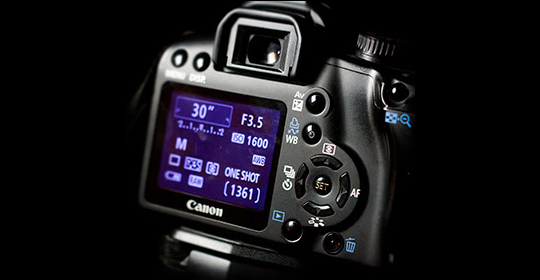
Choosing the Right Camera for the Job
The type of camera you will use depends on what you intend to photograph.
Because I mainly shoot deep-sky astronomical objects, a DSLR that I could attach to my telescope via a t-adapter was the logical choice. The DSLR also allows you to attach several different types of lenses to it for landscape astrophotography projects.
If you prefer to focus on taking pictures of the planets in our solar system, a webcam or dedicated astronomy camera may be a better fit for your needs.
If you are not interested in all of the technical settings and advanced controls included in a DSLR camera, a Point and Shoot model may be all you need for your landscape astrophotography goals.
If you are a serious amateur astronomer who wants to take your deep-sky astrophotography to the next level, a CCD camera or cooled CMOS camera is likely in your future.
Deep-Sky Astrophotography
This is the act of photographing deep-sky objects in space such as galaxies, nebulae, and globular clusters. These objects are usually cataloged as Messier Objects, NGC (New General Catalogue) or IC (Index Catalogues).
This is the realm where I spend the majority of my time.
A tracking telescope mount is required to compensate for the rotation of the Earth, and the apparent movement of the night sky. Without an Equatorial Mount, you will experience star trailing in exposures longer than 15-10 seconds.
The photo below shows the Heart Nebula using a Canon EOS Rebel T3i camera with a small APO refractor telescope.
The Heart Nebula – Canon DSLR and William Optics Z61 APO
Landscape Astrophotography
Landscape astrophotography has gained popularity over the years with the increasingly affordable DSLRs available.
These cameras are much more sensitive to light than ever before, and nobody can resist the allure of an image of the Milky Way. This type of photography can also include shots of constellations, planet conjunctions, the moon, and more.
This type of photography has quickly become a close second behind my interest in deep-sky imaging.
Attaching a camera lens to your DSLR is necessary for a wide-field view of space, rather than connecting the camera to a telescope.
For shots like the one below, I use a wide-angle camera lens on a small star tracker.
The Milky Way – Canon EF 17-40mm F/4L lens on an iOptron SkyGuider Pro
Solar System Imaging – Planetary Astrophotography
I began my photographic journey with this type of imaging. My first shots were of the Moon through my Orion 4.5 Reflector Telescope using the eyepiece projection method. I would use my Point-and-Shoot Canon Powershot digital camera through the eyepiece of the telescope for pictures of the Moon, Jupiter, Saturn, Mars, and Venus.
It is possible to photograph images of solar system objects through a non-tracking Dobsonian telescope using your smartphone, but it will be challenging to capture a clear shot at high magnifications. You can also capture wide-angle photographs of the planets with your DSLR camera as they dance across the night sky each night.
The Orion StarShoot 5 MP Solar System Color Camera is a popular choice for beginners due to its affordable price tag and solar system photography capabilities.
This camera uses a 5-megapixel one-shot-color imaging sensor with 2.2 x 2.2 micron pixels.
Orion StarShoot 5 MP Solar System Color Camera
This type of camera sensor is ideal for capturing images of planets like Saturn, Jupiter, and Mars because the images are highly magnified. You can either take single exposures during times of good seeing, or record video footage (AVI or MOV format) and stack the best frames in Registax.
The reason for this method is to compensate for varying levels of transparency in the Earth’s atmosphere. Some of the best planetary images in the world were taken using these inexpensive “webcam” style cameras.
Here is my photo of Jupiter – taken using a Canon PowerShot camera:
The planet Jupiter photographed through the telescope eyepiece.
Narrowband Deep-Sky Astrophotography
This is where it gets interesting. Narrowband imaging is used by professional astrophotographers around the world, including on the photos that were taken by the Hubble Space Telescope.
The concept behind this type of photography is to shoot your deep-sky object through different filters that only pick up certain wavelengths of light.
This is beneficial for several reasons, among them is being able to capture images under heavy light pollution. This is usually done with a cooled CCD or CMOS camera with an attached filter wheel.
I have captured many images using a color camera with narrowband filters, and have found it to be an excellent way to add more detail to my existing photos.
There will always be a learning curve to overcome when starting out with a new camera. I encourage you to join your local astronomy club or one of the many astrophotography communities on the web for specific advice about the camera you are using.
What Type of Camera do you Recommend?
No matter which type of astrophotography camera you use, the important thing is that it produces the results you are aiming for. Personally, I thought I would always shoot with a DSLR camera.
That all changed when I experienced the power of a dedicated astronomy camera with a cooled sensor and the high-quality, low-noise images it produced.
For my deep-sky imaging, a dedicated one-shot color astronomy camera such as the ZWO ASI2600MM Pro will likely become my primary imaging instrument for the time being.
I currently shoot most with a ZWO ASI2600MM Pro
Your camera should complement your style and imaging conditions. For me, it’s all about maximizing the short windows of imaging time I can squeeze in.
Please subscribe to the AstroBackyard Newsletter for my latest equipment reviews and astrophotography tutorials.
